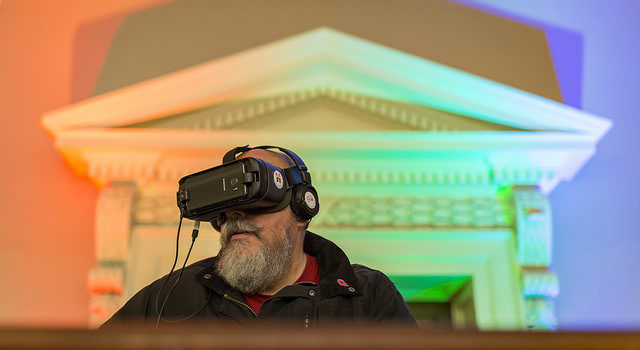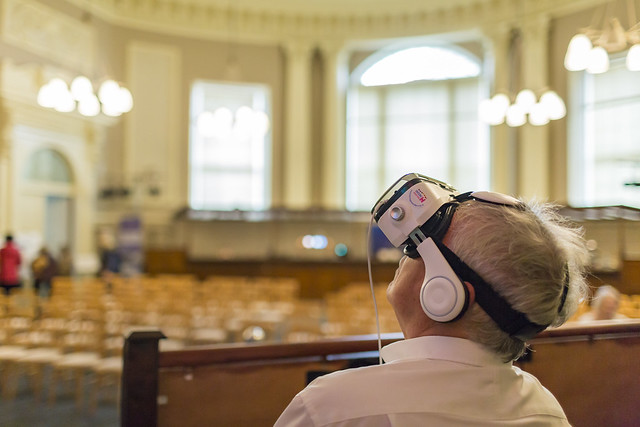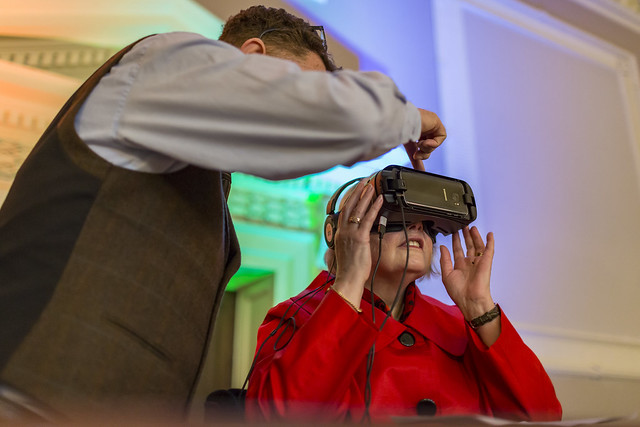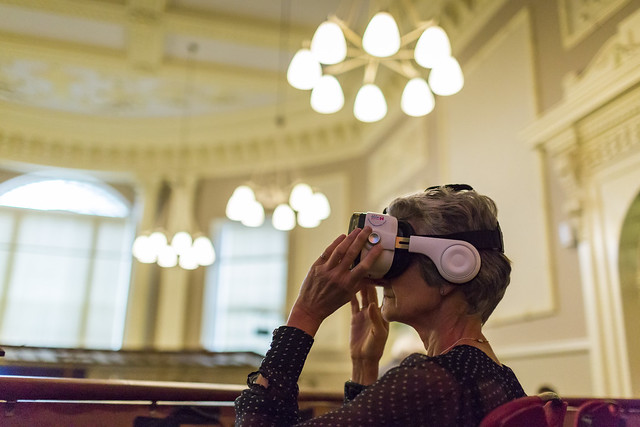 Play
Play
Regina v Turing and Murray – VR Experience
- by Hwa Jung
Filmmaker Tim Brunsden explains his approach to the VR filming.
Initial Idea
We'd decided early on in the project to have a virtual reality element to the project. Personally, I have a love, hate relationship with VR. The visual experience has the potential to be very interesting versus the wearing the headset can feel isolating and ridiculous. Using it in the right context and its relevance beyond the tech is essential so from the start we asked ourselves the question, Why use VR in the first place. The reasons we put forward were:-
- To utilise the set and the actors so that the VR is used to animate the courtroom space when the play wasn't on. What the viewing experience is like is as important as the practical making of the VR films. Having a ready made set and the chance to film and view in the actual courthouse where Turing and Murray were sentenced was a good opportunity to explore.
- The videos were mainly filmed in the same location as the one the viewer would be situated allowing people to really get a different point of view of the same space.
- As there was other things happening in the space at the same time, the headsets were a way to remove any visual distractions and allow the participants to focus on the thoughts of the characters.
- The VR allowed us to play visually with some of the thoughts, animating the space and adding another element to the recorded monologues, effectively, queering the space in some way.
- With specifically written monologues from the main characters, the difference pieces referenced the play, without it being essential to have seen it. This enabled the VR to add another layer to the storytelling and public engagement.
Filming the VR element of the project then took two forms. Planning the production schedule around the actors and rehearsals and doing some tests on the best equipment to view the films in situ in the courthouse over 4 days and within our budget.
Equipment

The VR equipment needed to be simple enough to use, not take up too much room and have power to last the distance of the four days.
I had the opportunity to attend a weekend workshop at VR Manchester which was really useful hands on research and led me to go for the Samsung Gear headset which works with the Samsung S phone range. I bought a cheaper S6 to start with but on testing, it seemed to get hot and shut down after an hours use so we also bought more expensive second hand S7 which had better battery life, using the S6 as a back up. The headset didn't come with a power cable, Samsung don't sell them in the UK apparently but I managed to find one online. The instructions say that the headset doesn't directly charge the phone (we found that it did, but we had loaded the film directly onto the phone and switched it to airplane mode which helped).
Our budget didn't stretch to another two Samsung Gear headsets, phones and back ups, so instead we went with two second hand iPhone 6's and cheaper BOBVR headsets. These cheaper headsets allowed us to keep the phones on charge, so we didn't need to buy back up's to allow for battery drain. We downloaded a VR player, loaded the films onto the phones and kept them on airplane mode.
I thought that the thought different headset combination would be a bit confusing, but it was actually a really good test to see how they held up over the four days. The Samsung was a better immersive experience, but the main Oculus Rift menu is more complicated to navigate to find the film and the headset has a touchpad control unit on the side of it which is easily knocked by participants. The iPhone VR player was much simpler to get started and a bit more robust, although the VR format is slightly less quality.
Production

The schedule was always going to be tight. We'd asked Steven Downs the writer/director of the play to also write some separate monologues, reimagining the thoughts of Alan Turing, Arnold Murray and Judge Harrison. We'd also asked writer and programmer Jay Bernard to write a short monologue reimagining what Arnold Murray may have been thinking at the time. As a young trans man, we were keen to include Jay's take on this. We had always been keen to highlight Murray as he is the one that tends to be forgotten, indeed many people who came to experience the VR did ask who Murray was. Turing's and Murray's experience was a good chance to talk about LGBT+ history and the law at the time.
The rehearsal schedule was tight for everyone. There was only three weeks to pull the show together, with limited rehearsal time in the venue. We managed to schedule in a couple of hours over two days to film the VR scenes in the Courthouse itself using key members of the cast, asking everyone else to leave the space while we filmed. Jay arrived just in time to direct the piece he had written on Murray. It was quite funny seeing him direct the actors whilst hiding behind some chairs at the back of the room so he wouldn't be picked up on the 360 camera.
It would have been useful to have a bit more time with the performers just to explain more about the process of what we were trying to achieve, but we had aimed to keep filming as simple as possible due to the lack of time and so they could focus on the play.
Filming was completed on the Sunday and all the films needed to be ready to go by Wednesday so we could test the setup before the first of the Heritage Open Days on Thursday. This left just two days to edit and export the films which was a bit of a rush but achievable. There were some tweaks that I would have liked to have made, such as the positioning of the view point on Murray's film, but I don't think this unduly affected the viewer experience.
Installation

Overall, for the four days, I think the combination of the play and the VR experience alongside worked really well. There wasn't too many technical problems with the kit (nothing that we couldn't solve).
I don't think there was a time when all the headsets weren't in use and the response was generally positive with many of the participants saying they had never used VR headsets before. The audience demographic for the play and the VR was generally an older crowd and it was great to be able to have conversations about the law and the treatments gay men were subjected to. There was also interesting tests with VR and glasses, hearing aids, focusing and generally clearly explaining what to do when wearing the headset. I mentioned to people you can look all around you when wearing the headset, but they would often just sit staring straight ahead.
We made a great effort to try and forget about the tech and really focus on the history and the story. A lot of the press angle seemed to be about people wearing the headsets and doing a 'wow' face which we avoided as it wasn't what we were trying to do. The man from the BBC asked, 'Is it like getting inside the mind of Turing?' No, it's like placing yourself in court in 1952 and thinking about what it would have been like for the 100,000 gay men who were convicted of consenting homosexual behaviour since it's outlawing in 1885, 15,000 of these men being convicted after the Sexual Offences Act was legislated in 1967.
Though we hadn't planned it, people who had experienced the VR and then saw the play, really did get an added layer to the story, one person saying that they were literally able to see what Turing was describing as they had seen the VR film beforehand. I think this kind of combination of live action and VR experience is something to explore further in the future.
Explore more photos and video of the VR experience below.
